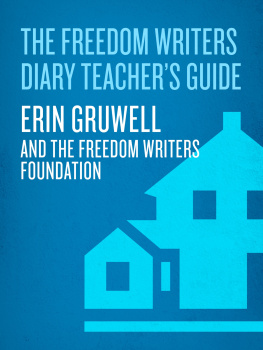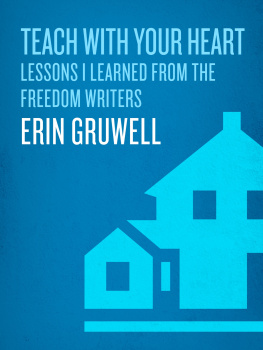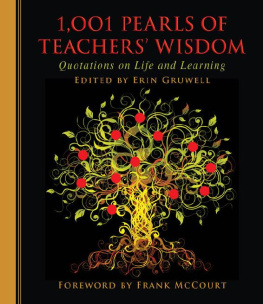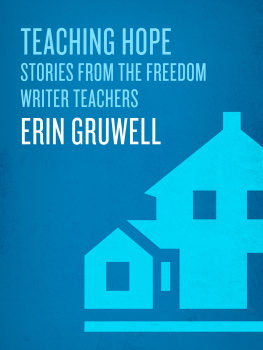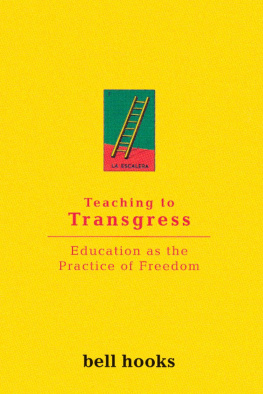Contents
Landmarks
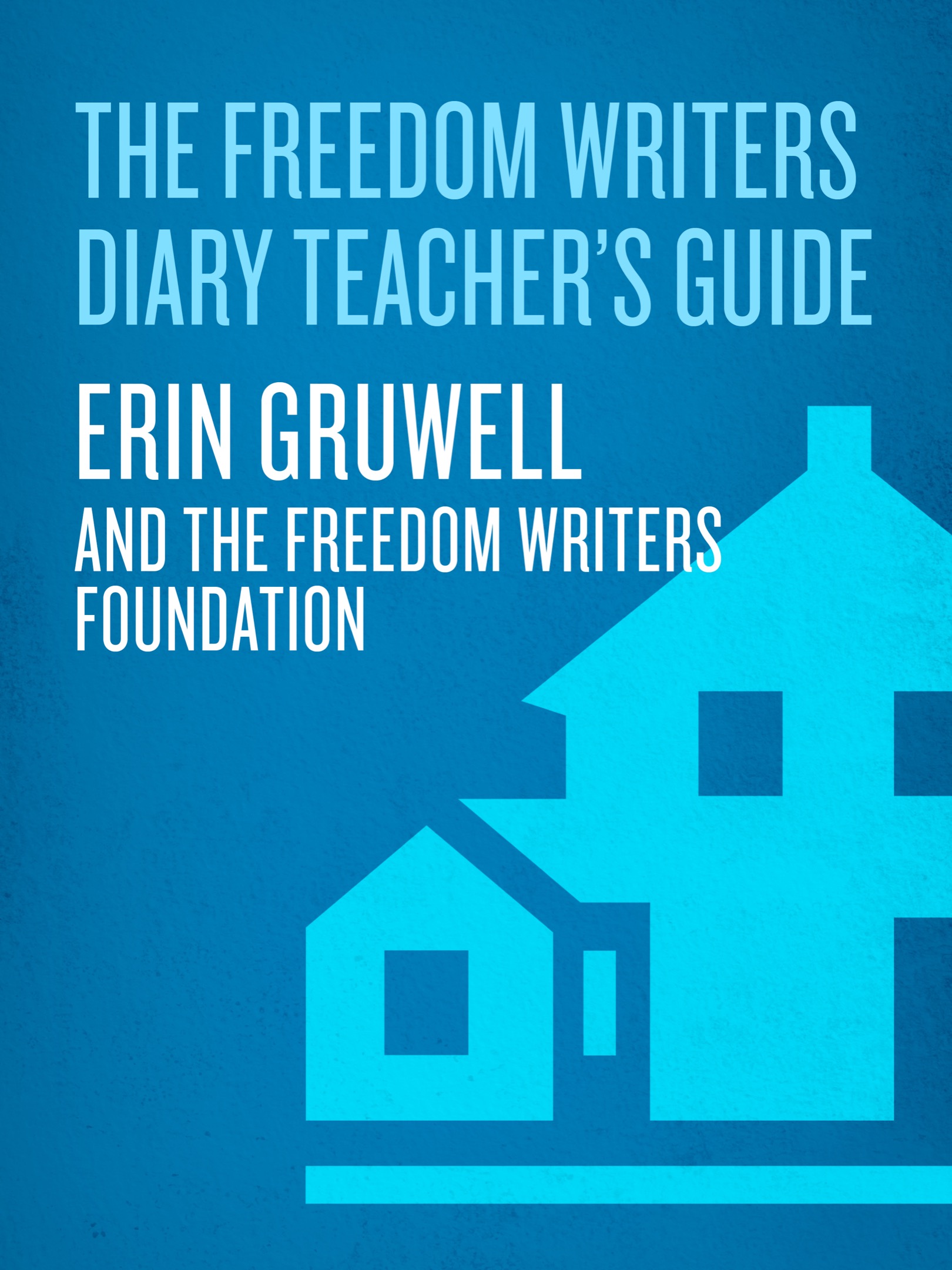
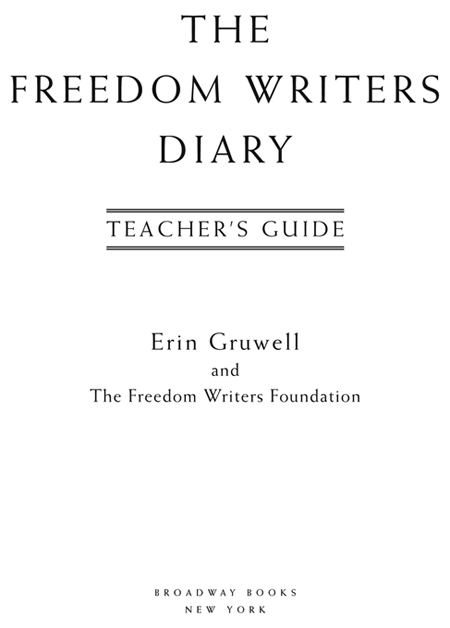
THE
FREEDOM WRITERS
DIARY
=======================
TEACHERS GUIDE
=======================
===========
Contents
===========
________________________________
THIS BOOK IS DEDICATED TO:
________________________________
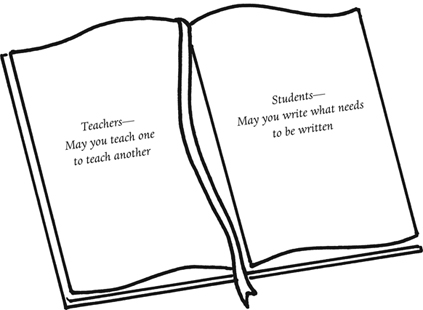
THE
FREEDOM WRITERS
DIARY
========================
TEACHERS GUIDE
========================
========================
Letter to the Educator
========================
Dear Educator,
Im so excited to have this opportunity to share The Freedom Writers Diary Teachers Guide with you. The guide includes many of the original activities that I did with the Freedom Writers in Room 203 at Woodrow Wilson High School in Long Beach, California, from 1994 to 1998. Several of these activities are derived from the students entries in The Freedom Writers Diary, and the Line Game and the Toast for Change were even featured in the movie Freedom Writers.
When I walked into my first class as a new teacher, I could not have been less prepared to deal with the harsh realities of the lives of my students or the way the outside world would crash into my classroom. These teenagers lived in a racially divided community and were already hardened by firsthand exposure to gang violence, broken homes, juvenile halls, and drugs. The obstacles these teens confronted as students became challenges for me as their teacher.
The 150 freshman who drifted into Room 203 had already been dubbed as the schools rejects. Sure enough, that hurtful judgment was reiterated several weeks later when I was told that my students were too stupid to read a book from cover to cover. My students were far from stupid, but they had certainly given up on education. They felt as if they had no reason to care about school; the potential rewards of college and a career seemed remote, even alien.
After hearing, Ms. G, this doesnt have anything to do with my life, more than once, I made it my mission to prove my students wrong by finding ways to make my lessons speak to their experiences and tap into their talents.
The students brought their histories of racial conflict into the classroom. They needed an educational philosophy that promoted tolerance and encouraged them to rethink their beliefs about themselves. I decided to assign books written by, for, and about teenagers who had lived during wars but were able to right the wrong by chronicling their own harrowing stories. To my amazement, students who had originally hated reading and writing became engrossed in reading Anne Franks The Diary of a Young Girl and Elie Wiesels Night. These books and others resonated with the reality of living in a dangerous urban environment, not long after the Los Angeles riots in 1992.
When one of my students exclaimed, I feel like I live in an undeclared war zone, I realized that these young people needed to be encouraged to pick up a pen rather than a gun. Tragically, this student had lost two dozen friends to gang violence. In an attempt to connect with my class, I gave my students journals in the hopes of giving them a voice. Before long, they began to pour out their stories openly, unburdened by the anxieties associated with spelling, grammar, and grades. Journals provided a safe place to become passionate writers communicating their own histories, their own insights. As they began to write down their thoughts and feelings, motivation blossomed. Suddenly, they had a forum for self-expression, and a place where they felt valued and validated.
As sophomores, my students were inspired to write letters to Miep Gies, the courageous woman who hid Anne Frank, and Zlata Filipovic, the teenage author who penned Zlatas Diary: A Childs Life in Sarajevo. When Miep Gies told my students to make sure that Annes death is not in vain, they understood her message that writing and storytelling have the power to change the world. Following in the footsteps of extraordinary teenagers like Anne and Zlata, my students used their own diaries to share their experiences of loss, hardship, and discrimination.
As juniors, I had my students watch a documentary about the Freedom Riders, the civil rights activists who rode integrated buses across the South in 1961. The courage of the Freedom Riders inspired my class to adopt the name Freedom Writers, reflecting the students determination to use their journals to speak out about the racism and intolerance that surrounded them. To celebrate their newfound identity, the Freedom Writers followed in the footsteps of the Freedom Riders and took a trip to Washington, D.C. In a symbolic tribute to their namesake, they delivered a bound copy of their favorite diary entries to Richard Riley, the U.S. Secretary of Education.
As a senior class, the Freedom Writers received the Spirit of Anne Frank Award for their commitment to combating discrimination, racism, and bias-related violence. They also devoted long hours to editing their journal entries and were rewarded with a publishing contract to turn their class book into what would become a number-one-ranked New York Times best-seller, The Freedom Writers Diary: How a Teacher and 150 Teens Used Writing to Change Themselves and the World Around Them (Broadway Books, 1999). But even more meaningful to the Freedom Writers than awards or publication was the moment they collectively walked across a graduation stage and claimed their high school diplomas, a feat few had thought possible.
After the Freedom Writers graduated from Wilson High in 1998, I made the difficult decision to trade my beloved Room 203 for California State University, Long Beach, where I became a Teacher in Residence in the College of Education. My goal was to help as many students as possible by teaching future educators the importance of working with at-risk kids who had been written off by the educational system. During my time at the university, some of my college students were Freedom Writers now pursuing careers in education. One of them once commented, The best part of Ms. Gs class [at Wilson High] was how shed start us on one of her off-the-wall activities and suddenly we were all coming up with our own ideas. It was like we were teaching the class with her. I think thats why so many of us want to be teachers. Hearing that, I began to dissect what truly happened in Room 203, in the hopes that my lesson plans could be replicated in other classrooms, regardless of age, academic ability, or socioeconomic level.
At the university, I discovered that some of the pedagogical strategies I had arrived at instinctively while teaching at Wilson High were supported by research in the field of education. I learned that educational psychologists strongly support a student-centered learning model based on internal motivation. Students who are internally motivated feel a sense of choice in the classroom and are more likely to achieve academic success. Teachers who support internal motivation listen to their students, engage interest, encourage questions, and allow their students flexibility in problem solving. Encouraged by this academic validation of my student-centered methods, I drew on my classroom experiences with the Freedom Writers and began to teach future educators how to motivate their students from the inside out.
Hundreds of future teachers later, a very successful businessman challenged me to bottle my Secret Sauce and take my pedagogical methods to the next level. With his help, as well as crucial input from many of the original Freedom Writers, we established the Freedom Writers Foundation, a nonprofit organization devoted to replicating the success of the Freedom Writers.

